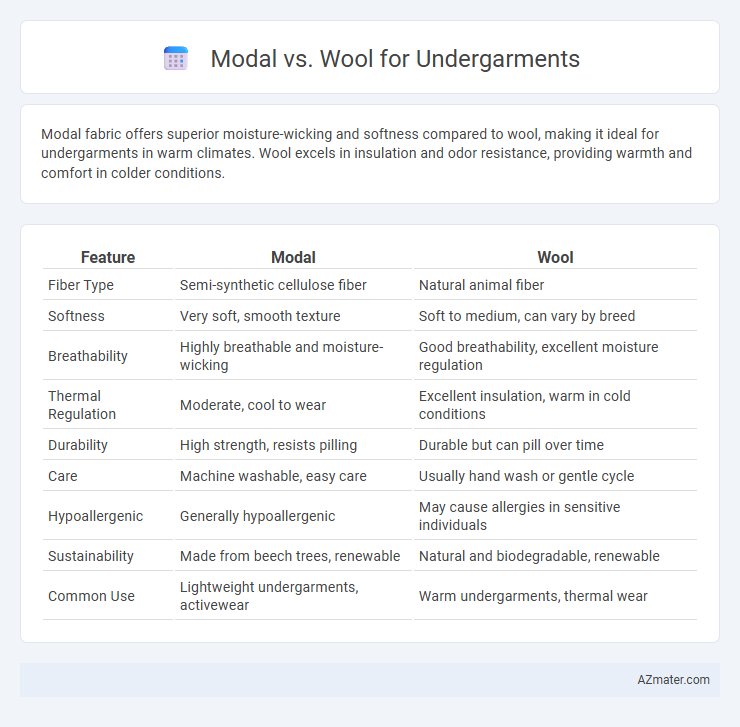Modal fabric offers superior moisture-wicking and softness compared to wool, making it ideal for undergarments in warm climates. Wool excels in insulation and odor resistance, providing warmth and comfort in colder conditions.
Table of Comparison
| Feature | Modal | Wool |
|---|---|---|
| Fiber Type | Semi-synthetic cellulose fiber | Natural animal fiber |
| Softness | Very soft, smooth texture | Soft to medium, can vary by breed |
| Breathability | Highly breathable and moisture-wicking | Good breathability, excellent moisture regulation |
| Thermal Regulation | Moderate, cool to wear | Excellent insulation, warm in cold conditions |
| Durability | High strength, resists pilling | Durable but can pill over time |
| Care | Machine washable, easy care | Usually hand wash or gentle cycle |
| Hypoallergenic | Generally hypoallergenic | May cause allergies in sensitive individuals |
| Sustainability | Made from beech trees, renewable | Natural and biodegradable, renewable |
| Common Use | Lightweight undergarments, activewear | Warm undergarments, thermal wear |
Introduction to Modal and Wool Fabrics
Modal fabric, derived from beech tree pulp, is a semi-synthetic fiber known for its exceptional softness, breathability, and moisture-wicking properties, making it ideal for undergarments that require comfort and durability. Wool, a natural fiber obtained from sheep, offers excellent insulation, temperature regulation, and natural odor resistance, providing superior warmth and comfort in cooler climates. Both Modal and Wool fibers serve distinct functional advantages in undergarment design, balancing softness, thermal regulation, and moisture management.
Understanding Modal: Composition and Properties
Modal, a semi-synthetic fiber made from beech tree pulp, is renowned for its softness, breathability, and moisture-wicking properties, making it ideal for undergarments. Unlike wool, Modal offers a smooth, lightweight texture that resists shrinking and fading, ensuring long-lasting comfort and durability. Its excellent ability to absorb moisture while remaining breathable enhances skin comfort, particularly in warm or active conditions.
Exploring Wool: Natural Benefits and Features
Wool undergarments provide superior moisture-wicking properties, effective temperature regulation, and natural odor resistance, making them ideal for both cold and warm conditions. The fibers' breathability and softness enhance overall comfort while maintaining durability and sustainability. Wool's hypoallergenic qualities and biodegradability offer eco-friendly advantages over synthetic alternatives such as Modal.
Comfort and Softness: Modal vs Wool
Modal fabric offers exceptional softness and a silky smooth texture, making it highly comfortable for undergarments that feel gentle against the skin. Wool provides natural warmth and breathability but can sometimes cause itchiness or irritation, especially in sensitive areas. For ultimate comfort and softness in undergarments, modal is often preferred due to its moisture-wicking properties and lightweight feel compared to the coarser texture of wool.
Moisture Wicking and Breathability Comparison
Modal fibers exhibit superior moisture-wicking properties compared to wool, effectively drawing sweat away from the skin to keep the wearer dry and comfortable. Wool, particularly merino wool, offers natural breathability with excellent temperature regulation but can retain more moisture than modal during intense physical activity. Choosing between modal and wool for undergarments depends on the balance between rapid moisture management and natural airflow suited to different activity levels.
Thermal Regulation: Warmth and Coolness
Modal fibers excel in moisture-wicking and breathability, maintaining a cool and comfortable feel during warm conditions, while wool's natural crimp traps air for superior insulation, providing exceptional warmth in cold environments. Wool's hygroscopic properties allow it to absorb moisture without feeling damp, enhancing thermal regulation by keeping the skin dry, whereas modal's smooth, soft texture enhances comfort during physical activity by quickly dispersing sweat. For undergarments, modal offers coolness and moisture control ideal for warmer climates, whereas wool is optimal for thermal warmth and moisture management in colder temperatures.
Durability and Longevity: Which Lasts Longer?
Modal fibers, made from beech tree pulp, offer softness but tend to have lower durability compared to wool. Wool, derived from sheep fleece, is naturally resilient and retains its shape and insulating properties longer, making it ideal for long-lasting undergarments. While modal provides comfort, wool undergarments surpass in longevity and sustained durability through repeated wear and washing cycles.
Skin Sensitivity and Allergen Considerations
Modal fabric, derived from beech tree cellulose, offers exceptional softness and breathability, making it ideal for sensitive skin and reducing irritation risk. Wool, particularly merino wool, provides excellent moisture-wicking and temperature regulation but may cause itching or allergic reactions in individuals prone to wool allergies. Choosing modal over wool for undergarments benefits those with skin sensitivities by minimizing allergen exposure and enhancing overall comfort.
Sustainability and Environmental Impact
Modal fabric, made from beech tree pulp, offers a sustainable alternative to conventional cotton due to its lower water consumption and biodegradability, making it eco-friendly for undergarments. Wool, especially when sourced from ethically managed farms, is a natural, renewable resource known for its durability, breathability, and biodegradability, reducing environmental impact over time. Both fibers reduce reliance on synthetic materials with high carbon footprints, though Modal excels in water efficiency while Wool provides superior insulation and longevity.
Choosing the Best Undergarment: Modal or Wool?
Modal undergarments offer exceptional softness, breathability, and moisture-wicking properties, making them ideal for sensitive skin and active lifestyles. Wool, especially merino, provides superior temperature regulation and natural odor resistance, which is beneficial for colder climates or extended wear. Choosing between modal and wool depends on personal comfort preferences, climate conditions, and specific needs for moisture management or insulation.

Infographic: Modal vs Wool for Undergarment
 azmater.com
azmater.com